Changes and Characteristics of Green Infrastructure Network Based on Spatio-Temporal Priority
Abstract
:1. Introduction
2. Materials and Methods
2.1. Study Area
2.2. Data Sources and Processing
2.3. Methods
2.3.1. Extract GI Elements
2.3.2. Identify Spatial Prioritization
3. Results and Analysis
3.1. GI Source Spatial Prioritization
3.2. GI Corridors Spatial Prioritization
3.3. GI Codes’ Spatial Prioritization
3.4. GI Network Spatio-Temporal Evolution
4. Discussion and Conclusions
4.1. A New Perspective and Framework of Green Infrastructure Network Construction
4.2. Reveal the Spatial Distribution of Key GI Elements and GI Network variations
4.3. GI Network Construction, Optimization and Differentiated Governance
4.4. Limitations and Uncertainties
Author Contributions
Funding
Institutional Review Board Statement
Informed Consent Statement
Data Availability Statement
Acknowledgments
Conflicts of Interest
References
- Lovell, S.T.; Taylor, J.R. Supplying urban ecosystem services through multifunctional green infrastructure in the United States. Landsc. Ecol. 2013, 28, 1447–1463. [Google Scholar] [CrossRef]
- Finewood, M.H.; Matsler, A.M.; Zivkovich, J. Green infrastructure and the hidden politics of urban stormwater governance in a postindustrial city. Ann. Am. Assoc. Geogr. 2019, 109, 909–925. [Google Scholar] [CrossRef]
- Kumar, P.; Druckman, A.; Gallagher, J.; Gatersleben, B.; Allison, S.; Eisenman, T.S.; Hoang, U.; Hama, S.; Tiwari, A.; Sharma, A.; et al. The nexus between air pollution, green infrastructure and human health. Environ. Int. 2019, 133, 105181. [Google Scholar] [CrossRef] [PubMed]
- Butchart, S.H.; Walpole, M.; Collen, B.; Van Strien, A.; Scharlemann, J.P.; Almond, R.E.; Baillie, J.E.; Bomhard, B.; Brown, C.; Bruno, J.; et al. Global biodiversity: Indicators of recent declines. Science 2010, 328, 1164–1168. [Google Scholar] [CrossRef]
- Rands, M.R.; Adams, W.M.; Bennun, L.; Butchart, S.H.; Clements, A.; Coomes, D.; Entwistle, A.; Hodge, I.; Kapos, V.; Scharlemann, J.P.; et al. Biodiversity conservation: Challenges beyond 2010. Science 2010, 329, 1298–1303. [Google Scholar] [CrossRef] [Green Version]
- Parker, J.; Zingoni de Baro, M.E. Green infrastructure in the urban environment: A systematic quantitative review. Sustainability 2019, 11, 3182. [Google Scholar] [CrossRef] [Green Version]
- Millennium Ecosystem Assessment M E A. Ecosystems and Human Well-Being; Island Press: Washington, DC, USA, 2005. [Google Scholar]
- Shafique, M.; Kim, R. Recent Progress in Low-Impact Development in South Korea: Water-Management Policies, Challenges and Opportunities. Water 2018, 10, 435. [Google Scholar] [CrossRef] [Green Version]
- Newman, G.; Sansom, G.T.; Yu, S.; Kirsch, K.R.; Li, D.; Kim, Y.; Horney, J.A.; Kim, G.; Musharrat, S. A Framework for Evaluating the Effects of Green Infrastructure in Mitigating Pollutant Transferal and Flood Events in Sunnyside, Houston, TX. Sustainability 2022, 14, 4247. [Google Scholar] [CrossRef]
- Li, X.; Stringer, L.C.; Dallimer, M. The role of blue green infrastructure in the urban thesrmal environment across seasons and local climate zones in East Africa. Sustain. Cities Soc. 2022, 80, 103798. [Google Scholar] [CrossRef]
- Brzoska, P.; Spāģe, A. From city-to site-dimension: Assessing the urban ecosystem services of different types of green infra-structure. Land 2020, 9, 150. [Google Scholar] [CrossRef]
- Fňukalová, E.; Zýka, V.; Romportl, D. The Network of Green Infrastructure Based on Ecosystem Services Supply in Central Europe. Land 2021, 10, 592. [Google Scholar] [CrossRef]
- Wright, H. Understanding green infrastructure: The development of a contested concept in England. Local Environ. 2011, 16, 1003–1019. [Google Scholar] [CrossRef]
- Johnson, C.; Tilt, J.H.; Ries, P.D.; Shindler, B. Continuing professional education for green infrastructure: Fostering collaboration through interdisciplinary trainings. Urban For. Urban Green. 2019, 41, 283–291. [Google Scholar] [CrossRef]
- Wang, J.; Banzhaf, E. Towards a better understanding of Green Infrastructure: A critical review. Ecol. Indic. 2018, 85, 758–772. [Google Scholar] [CrossRef]
- Benedict, M.A.; McMahon, E.T. Green Infrastructure: Linking Landscapes and Communities; Island Press: Washington, DC, USA, 2012. [Google Scholar]
- Cameron, R.W.; Blanuša, T.; Taylor, J.E.; Salisbury, A.; Halstead, A.J.; Henricot, B.; Thompson, K. The domestic garden–Its contribution to urban green infrastructure. Urban For. Urban Green. 2012, 11, 129–137. [Google Scholar] [CrossRef]
- Tzoulas, K.; Korpela, K.; Venn, S.; Yli-Pelkonen, V.; Kaźmierczak, A.; Niemela, J.; James, P. Promoting ecosystem and human health in urban areas using Green Infrastructure: A literature review. Landsc. Urban Plan. 2007, 81, 167–178. [Google Scholar] [CrossRef] [Green Version]
- Meng, T.; Hsu, D. Stated preferences for smart green infrastructure in stormwater management. Landsc. Urban Plan. 2019, 187, 1–10. [Google Scholar] [CrossRef]
- Meerow, S.; Newell, J.P. Spatial planning for multifunctional green infrastructure: Growing resilience in Detroit. Landsc. Urban Plan. 2017, 159, 62–75. [Google Scholar] [CrossRef]
- Slätmo, E.; Nilsson, K.; Turunen, E. Implementing Green Infrastructure in Spatial Planning in Europe. Land 2019, 8, 62. [Google Scholar] [CrossRef] [Green Version]
- Ferreira, J.C.; Monteiro, R.; Silva, V.R. Planning a green infrastructure network from theory to practice: The case study of Setúbal, Portugal. Sustainability 2021, 13, 8432. [Google Scholar] [CrossRef]
- Monteiro, R.; Ferreira, J.C.; Antunes, P. Green Infrastructure Planning Principles: An Integrated Literature Review. Land 2020, 9, 525. [Google Scholar] [CrossRef]
- Beaujean, S.; Nor, A.N.M.; Brewer, T.; Zamorano, J.G.; Dumitriu, A.C.; Harris, J.; Corstanje, R. A multistep approach to improving connectivity and co-use of spatial ecological networks in cities. Landsc. Ecol. 2021, 36, 2077–2093. [Google Scholar] [CrossRef]
- Kang, J.; Zhang, X.; Zhu, X.; Zhang, B. Ecological security pattern: A new idea for balancing regional development and ecological protection. A case study of the Jiaodong Peninsula, China. Glob. Ecol. Conserv. 2021, 26, e01472. [Google Scholar] [CrossRef]
- Mubareka, S.; Estreguil, C.; Baranzelli, C.; Gomes, C.R.; Lavalle, C.; Hofer, B. A land-use-based modelling chain to assess the impacts of Natural Water Re-tention Measures on Europe’s Green Infrastructure. Int. J. Geogr. Inf. Sci. 2013, 27, 1740–1763. [Google Scholar] [CrossRef]
- Angelstam, P.; Khaulyak, O.; Yamelynets, T.; Mozgeris, G.; Naumov, V.; Chmielewski, T.J.; Elbakidze, M.; Manton, M.; Prots, B.; Valasiuk, S. Green infrastructure development at European Union’s eastern border: Effects of road infrastructure and forest habitat loss. J. Environ. Manag. 2017, 193, 300–311. [Google Scholar] [CrossRef] [PubMed]
- Liquete, C.; Kleeschulte, S.; Dige, G.; Maes, J.; Grizzetti, B.; Olah, B.; Zulian, G. Mapping green infrastructure based on ecosystem services and ecological networks: A Pan-European case study. Environ. Sci. Policy 2015, 54, 268–280. [Google Scholar] [CrossRef]
- Wei, S.; Pan, J.; Liu, X. Landscape ecological safety assessment and landscape pattern optimization in arid inland river basin: Take Ganzhou District as an example. Hum. Ecol. Risk Assess. Int. J. 2020, 26, 782–806. [Google Scholar] [CrossRef]
- Zhang, Z.; Meerow, S.; Newell, J.P.; Lindquist, M. Enhancing landscape connectivity through multifunctional green infrastructure corridor modeling and design. Urban For. Urban Green. 2019, 38, 305–317. [Google Scholar] [CrossRef]
- Sun, H.; Liu, C.; Wei, J. Identifying Key Sites of Green Infrastructure to Support Ecological Restoration in the Urban Agglomeration. Land 2021, 10, 1196. [Google Scholar] [CrossRef]
- Omitaomu, O.A.; Kotikot, S.M.; Parish, E.S. Planning green infrastructure placement based on projected precipitation data. J. Environ. Manag. 2021, 279, 111718. [Google Scholar] [CrossRef]
- McRae, B.H.; Dickson, B.G.; Keitt, T.H.; Shah, V.B. Using circuit theory to model connectivity in ecology, evolution, and conservation. Ecology 2008, 89, 2712–2724. [Google Scholar] [CrossRef] [PubMed]
- Cannas, I.; Lai, S.; Leone, F.; Zoppi, C. Green Infrastructure and Ecological Corridors: A Regional Study Concerning Sardinia. Sustainability 2018, 10, 1265. [Google Scholar] [CrossRef] [Green Version]
- Ye, H.; Yang, Z.; Xu, X. Ecological Corridors Analysis Based on MSPA and MCR Model—A Case Study of the Tomur World Natural Heritage Region. Sustainability 2020, 12, 959. [Google Scholar] [CrossRef] [Green Version]
- Benedict, M.A.; McMahon, E.T. Green infrastructure: Smart conservation for the 21st century. Renew. Resour. J. 2002, 20, 12–17. [Google Scholar]
- Weng, H.; Gao, Y.; Su, X.; Yang, X.; Cheng, F.; Ma, R.; Liu, Y.; Zhang, W.; Zheng, L. Spatial-Temporal Changes and Driving Force Analysis of Green Space in Coastal Cities of Southeast China over the Past 20 Years. Land 2021, 10, 537. [Google Scholar] [CrossRef]
- Weber, T.; Sloan, A.; Wolf, J. Maryland’s Green Infrastructure Assessment: Development of a comprehensive approach to land conservation. Landsc. Urban Plan. 2006, 77, 94–110. [Google Scholar] [CrossRef]
- Ou, X.; Lyu, Y.; Liu, Y.; Zheng, X.; Li, F. Integrated multi-hazard risk to social-ecological systems with green infrastructure prioritization: A case study of the Yangtze River Delta, China. Ecol. Indic. 2022, 136, 108639. [Google Scholar] [CrossRef]
- Snäll, T.; Lehtomäki, J.; Arponen, A.; Elith, J.; Moilanen, A. Green infrastructure design based on spatial conservation prioritization and modeling of biodiversity features and ecosystem services. Environ. Manag. 2016, 57, 251–256. [Google Scholar] [CrossRef] [Green Version]
- Watts, M.E.; Ball, I.R.; Stewart, R.S.; Klein, C.J.; Wilson, K.; Steinback, C.; Lourival, R.; Kircher, L.; Possingham, H.P. Marxan with Zones: Software for optimal conservation based land-and sea-use zoning. Environ. Model. Softw. 2009, 24, 1513–1521. [Google Scholar] [CrossRef] [Green Version]
- Taylor, P.D.; Fahrig, L.; Henein, K.; Merriam, G. Connectivity is a vital element of landscape structure. Oikos 1993, 68, 571–573. [Google Scholar] [CrossRef] [Green Version]
- Kim, D.; Song, S.K. The multifunctional benefits of green infrastructure in community development: An analytical review based on 447 cases. Sustainability 2019, 11, 3917. [Google Scholar] [CrossRef] [Green Version]
- Rusche, K.; Reimer, M.; Stichmann, R. Mapping and Assessing Green Infrastructure Connectivity in European City Regions. Sustainability 2019, 11, 1819. [Google Scholar] [CrossRef] [Green Version]
- Crooks, K.R.; Sanjayan, M. Connectivity conservation: Maintaining connections for nature. In Connect Conservation; Cambridge University Press: Cambridge, UK, 2006; pp. 1–99. [Google Scholar] [CrossRef]
- Ahern, J. Greenways as a planning strategy. Landsc. Urban Plan. 1995, 33, 131–155. [Google Scholar] [CrossRef]
- Préau, C.; Grandjean, F.; Sellier, Y.; Gailledrat, M.; Bertrand, R.; Isselin-Nondedeu, F. Habitat patches for newts in the face of climate change: Local scale assessment combining niche modelling and graph theory. Sci. Rep. 2020, 10, 3570. [Google Scholar] [CrossRef]
- Bolliger, J.; Silbernagel, J. Contribution of Connectivity Assessments to Green Infrastructure (GI). ISPRS Int. J. Geo-Inf. 2020, 9, 212. [Google Scholar] [CrossRef] [Green Version]
- Molla, M.B.; Ikporukpo, C.; Olatubara, C. The spatio-temporal pattern of urban green spaces in southern Ethiopia. Am. J. Geogr. Inform. Syst. 2018, 7, 1–14. [Google Scholar]
- Chiesura, A. The role of urban parks for the sustainable city. Landsc. Urban Plan. 2004, 68, 129–138. [Google Scholar] [CrossRef]
- Kemarau, R.A.; Eboy, O.V. Spatial Temporal of Urban Green Space in Tropical City of Kuching, Sarawak, Malaysia. J. Appl. Sci. Process Eng. 2021, 8, 660–670. [Google Scholar] [CrossRef]
- Chen, C.; Bi, L.; Zhu, K. Study on Spatial-Temporal Change of Urban Green Space in Yangtze River Economic Belt and Its Driving Mechanism. Int. J. Environ. Res. Public Health 2021, 18, 12498. [Google Scholar] [CrossRef]
- Woldesemayat, E.M.; Genovese, P.V. Monitoring Urban Expansion and Urban Green Spaces Change in Addis Ababa: Directional and Zonal Analysis Integrated with Landscape Expansion Index. Forests 2021, 12, 389. [Google Scholar] [CrossRef]
- Siddique, G.; Roy, A.; Mandal, M.H.; Ghosh, S.; Basak, A.; Singh, M.; Mukherjee, N. An assessment on the changing status of urban green space in Asansol city, West Bengal. GeoJournal 2020, 87, 1299–1321. [Google Scholar] [CrossRef]
- Rahaman, S.; Jahangir, S.; Haque, S.; Chen, R.; Kumar, P. Spatio-temporal changes of green spaces and their impact on urban environment of Mumbai, India. Environ. Dev. Sustain. 2021, 23, 6481–6501. [Google Scholar] [CrossRef]
- Kim, I.; Kwon, H. Assessing the Impacts of Urban Land Use Changes on Regional Ecosystem Services According to Urban Green Space Policies Via the Patch-Based Cellular Automata Model. Environ. Manag. 2021, 67, 192–204. [Google Scholar] [CrossRef]
- Pugh, T.A.; MacKenzie, A.R.; Whyatt, J.D.; Hewitt, C.N. Effectiveness of green infrastructure for improvement of air quality in urban street canyons. Environ. Sci. Technol. 2012, 46, 7692–7699. [Google Scholar] [CrossRef] [PubMed] [Green Version]
- Demuzere, M.; Orru, K.; Heidrich, O.; Olazabal, E.; Geneletti, D.; Orru, H.; Bhave, A.G.; Mittal, N.; Feliú, E.; Faehnle, M. Mitigating and adapting to climate change: Multi-functional and multi-scale assess-ment of green urban infrastructure. J. Environ. Manag. 2014, 146, 107–115. [Google Scholar] [CrossRef] [PubMed]
- Vogt, P.; Riitters, K.H.; Iwanowski, M.; Estreguil, C.; Kozak, J.; Soille, P. Mapping landscape corridors. Ecol. Indic. 2007, 7, 481–488. [Google Scholar] [CrossRef]
- Shi, X.; Qin, M. Research on the Optimization of Regional Green Infrastructure Network. Sustainability 2018, 10, 4649. [Google Scholar] [CrossRef] [Green Version]
- Wickham, J.D.; Riitters, K.H.; Wade, T.G.; Vogt, P. A national assessment of green infrastructure and change for the conterminous United States using morphological image processing. Landsc. Urban Plan. 2010, 94, 186–195. [Google Scholar] [CrossRef]
- Soille, P.; Vogt, P. Morphological segmentation of binary patterns. Pattern Recognit. Lett. 2009, 30, 456–459. [Google Scholar] [CrossRef]
- Carlier, J.; Moran, J. Landscape typology and ecological connectivity assessment to inform Greenway design. Sci. Total Environ. 2019, 651, 3241–3252. [Google Scholar] [CrossRef]
- Zhu, K.-W.; Chen, Y.-C.; Zhang, S.; Yang, Z.-M.; Huang, L.; Lei, B.; Li, L.; Zhou, Z.-B.; Xiong, H.-L.; Li, X.-X. Identification and prevention of agricultural non-point source pollution risk based on the minimum cumulative resistance model. Glob. Ecol. Conserv. 2020, 23, e01149. [Google Scholar] [CrossRef]
- Cadavid-Florez, L.; Laborde, J.; Mclean, D.J. Isolated trees and small woody patches greatly contribute to connectivity in highly fragmented tropical landscapes. Landsc. Urban Plan. 2020, 196, 103745. [Google Scholar] [CrossRef]
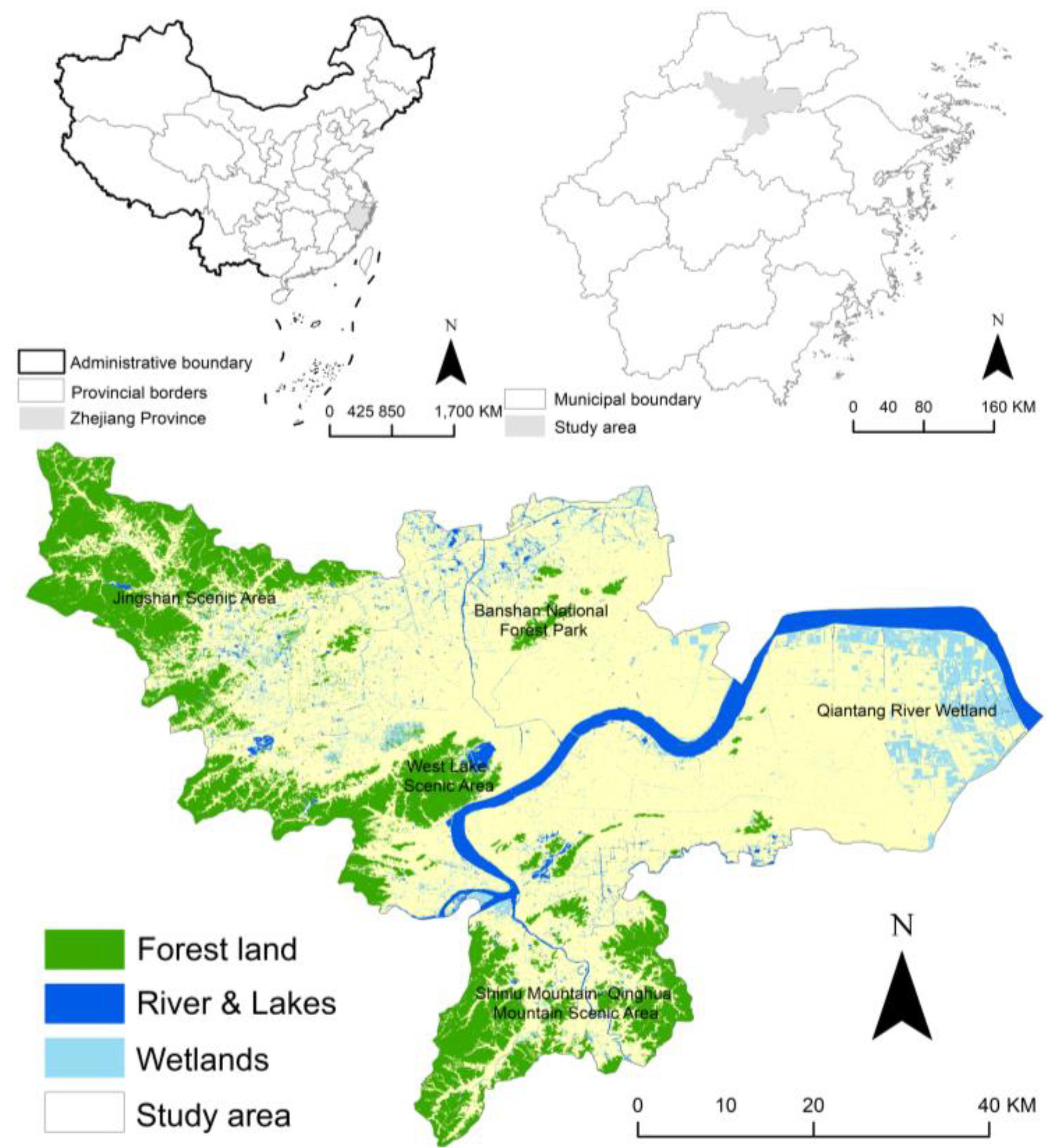

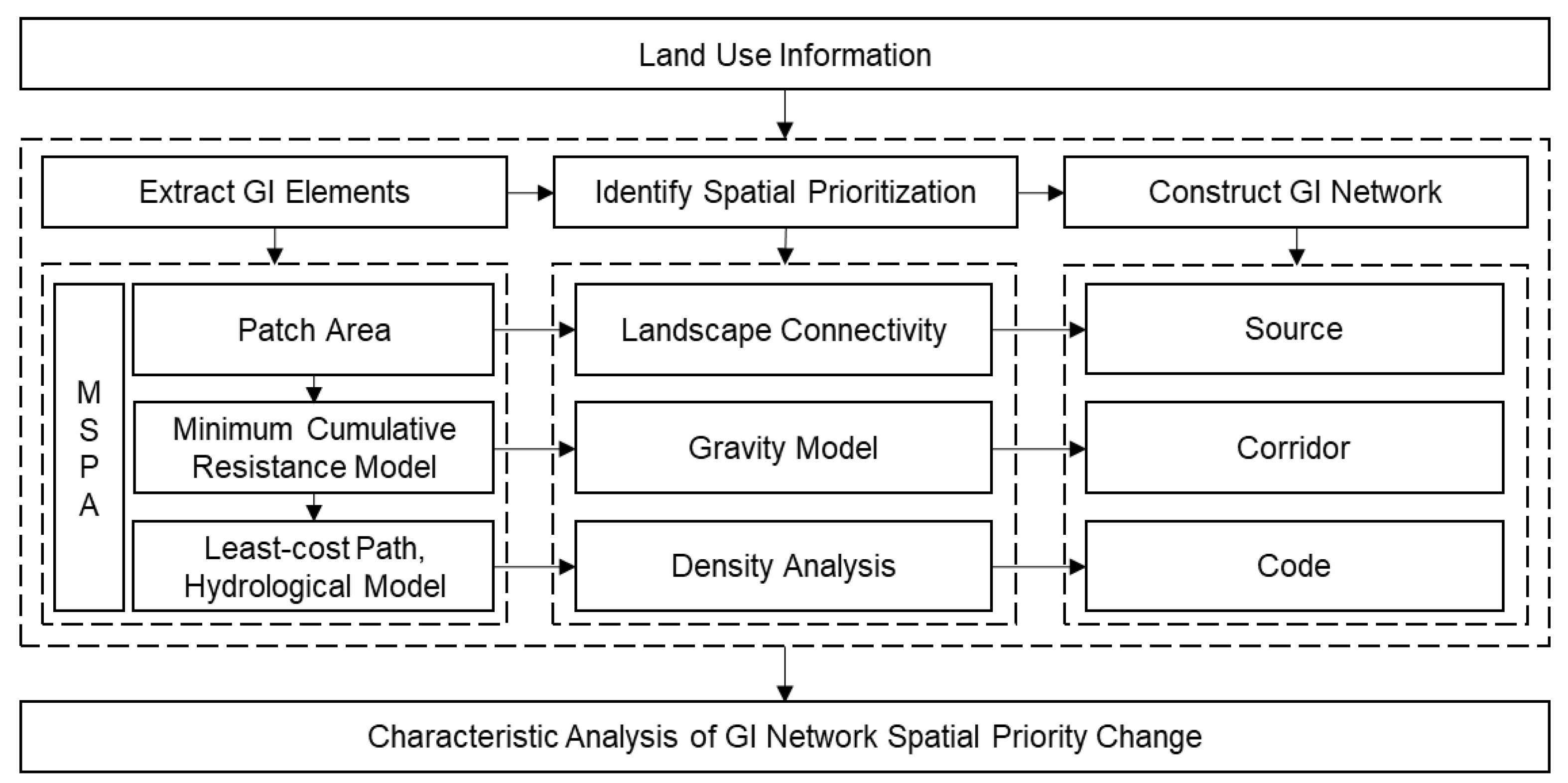

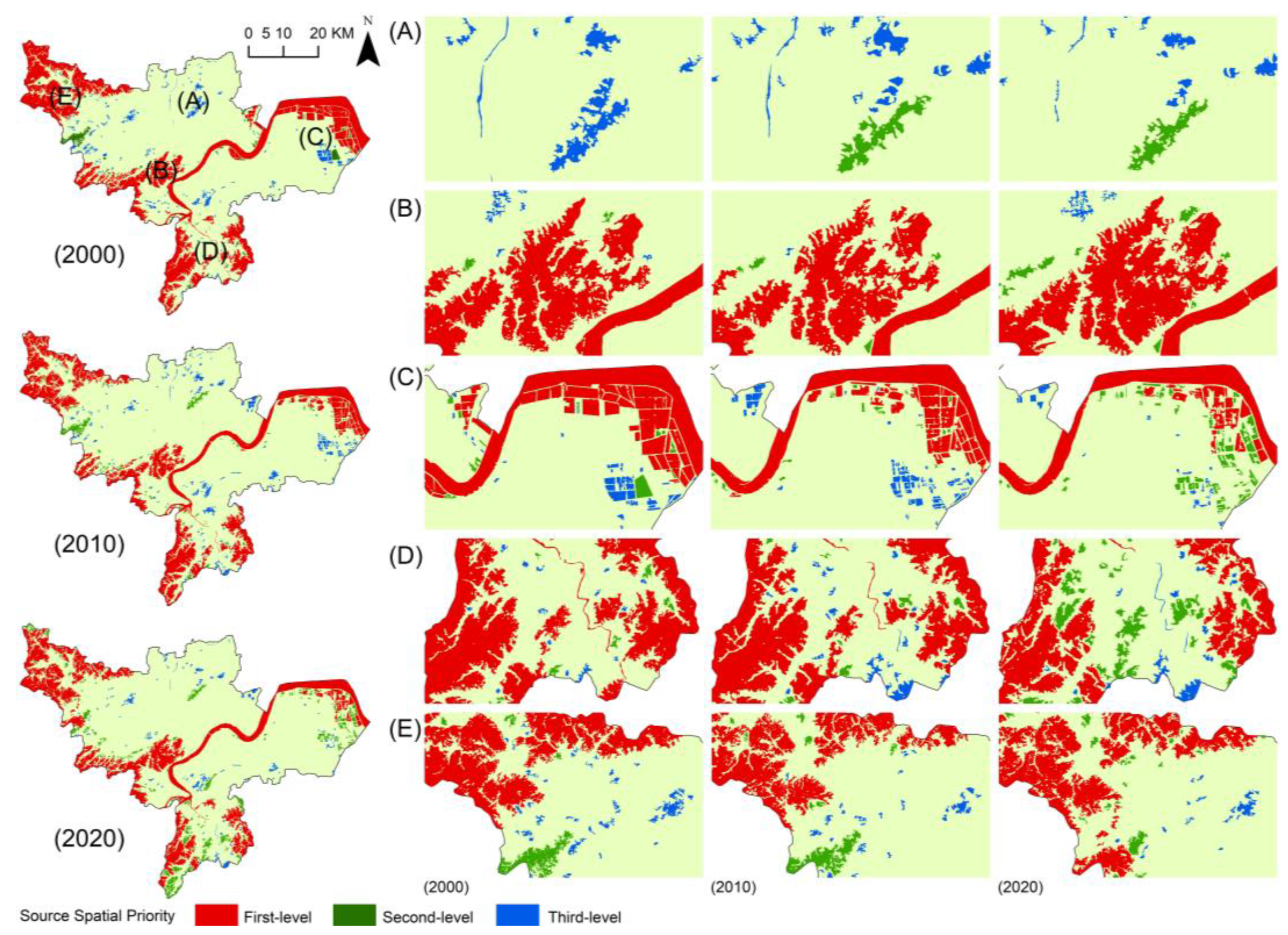
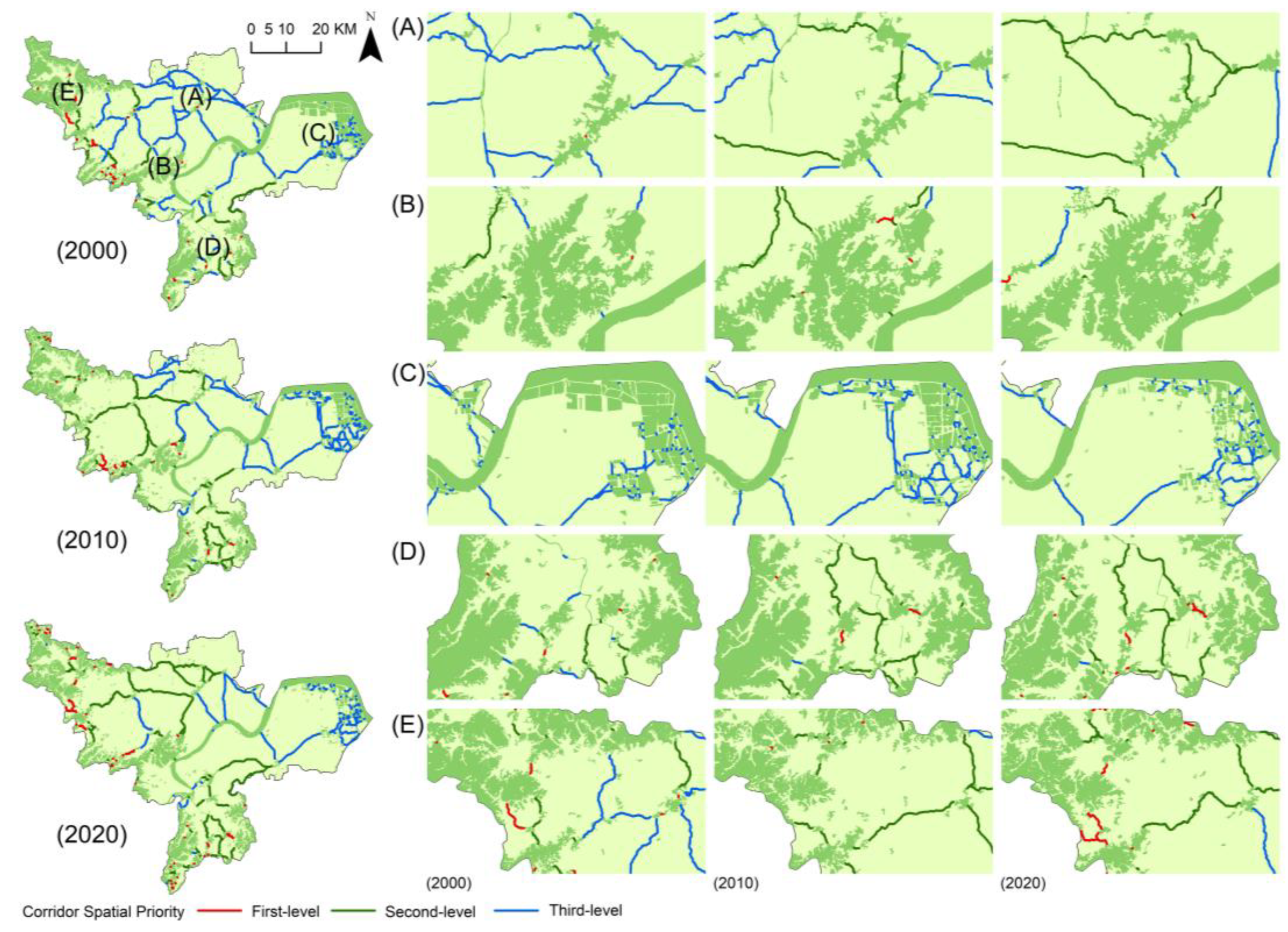
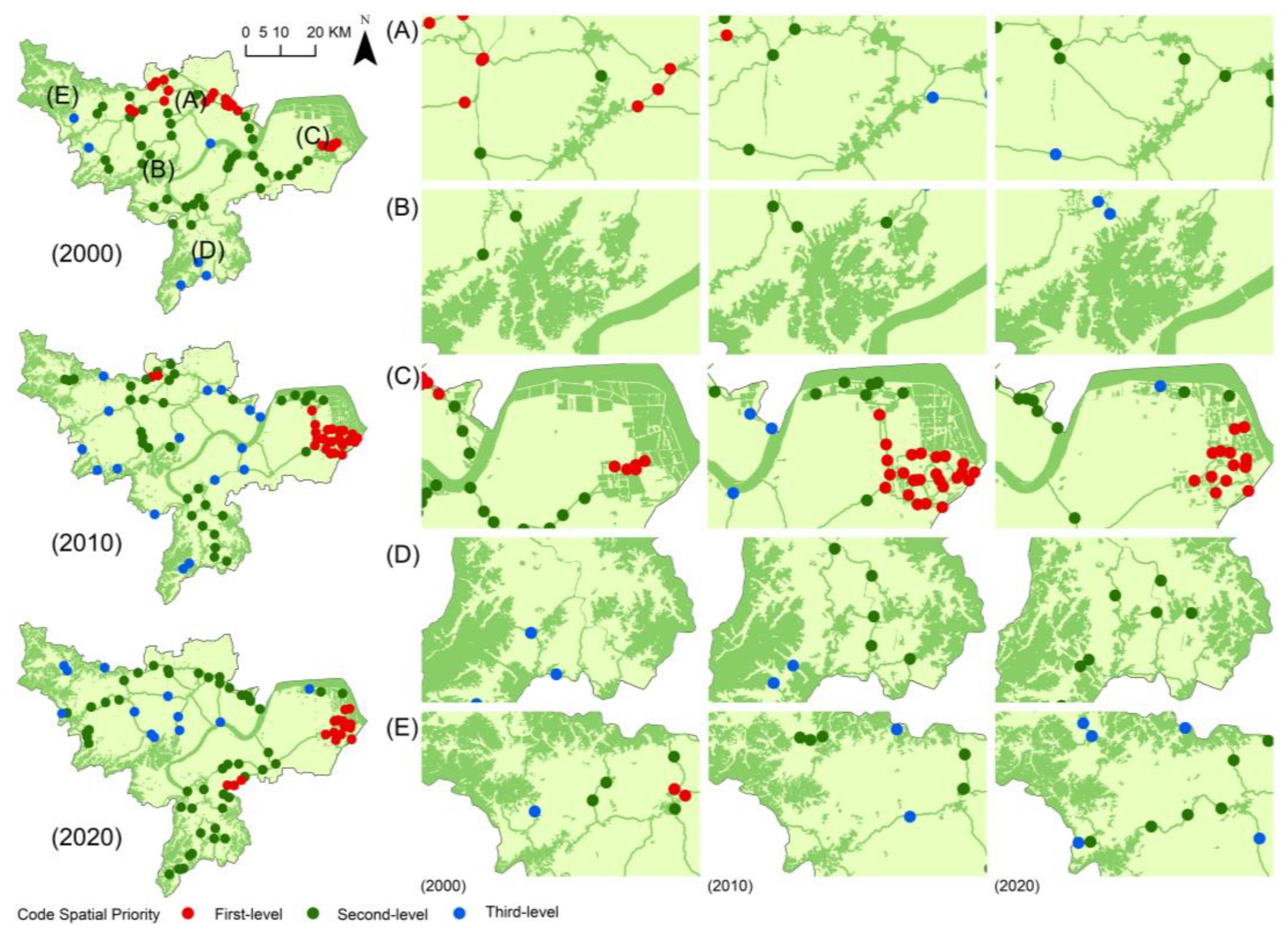
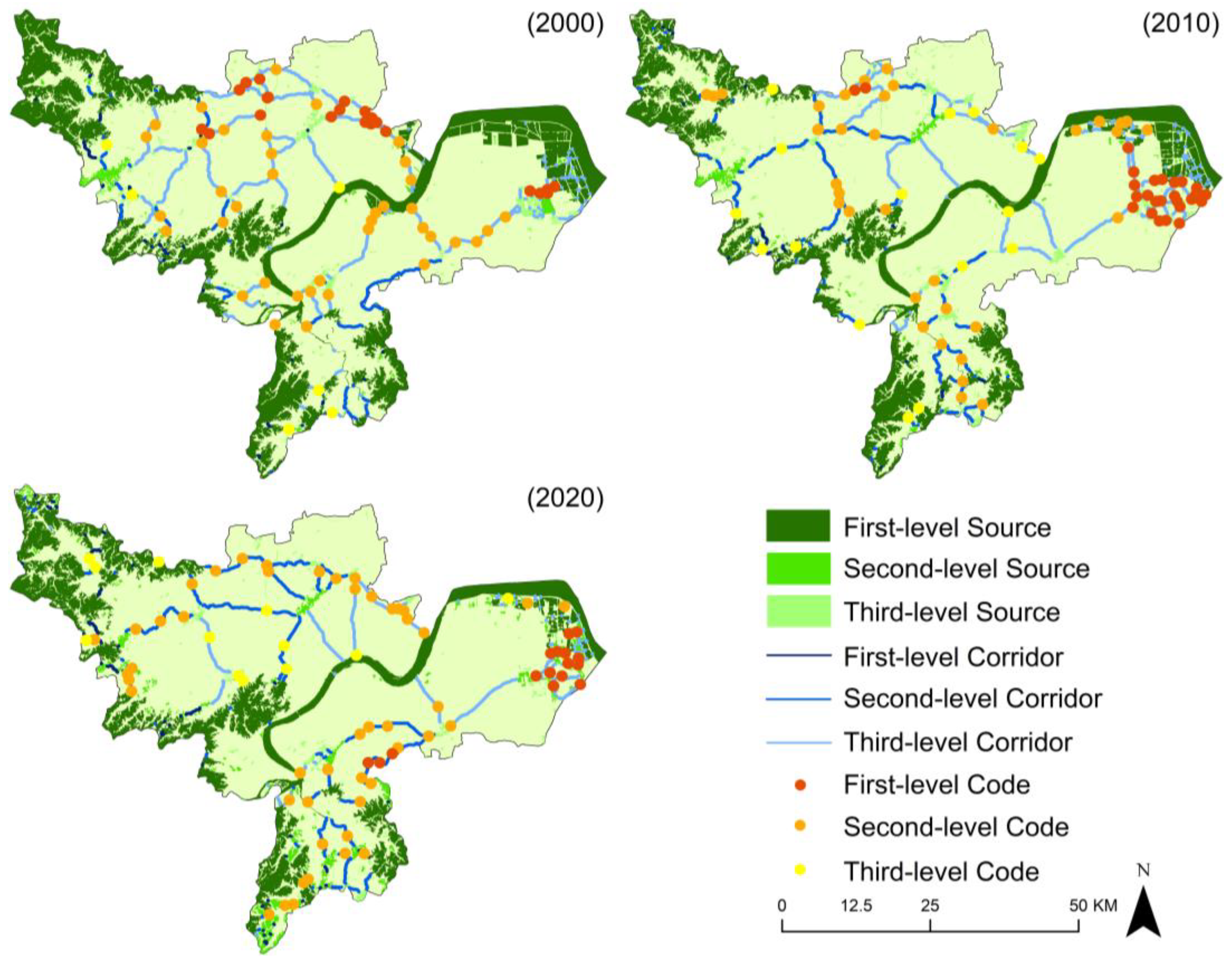
| Research Aspect | Research Content/Methods |
|---|---|
| Green Infrastructure application in urban services | Stormwater management, climate regulation, urban greening, and so on |
| Green Infrastructure network construction | Select the specific LULC types, spatial overlay approach |
| Green Infrastructure elements extraction | MSPA, InVEST model, MCR model, circuit theory model, Linkage Mapper, and so on |
| Green Infrastructure network evaluation | Ecological connectivity index, landscape pattern index, landscape connectivity index, and so on |
| Green Infrastructure network prioritization | GIS-based multicriteria evaluation methods, the progressive Green Infrastructure zoning method, the participatory mapping method, the SCP method, and so on |
| Resistance Type | Resistance Coefficient | Resistance Factor | Resistance Value |
|---|---|---|---|
| MSPA Landscape Type | 0.48 | Core | 5 |
| Bridge | 10 | ||
| Loop | 20 | ||
| Branch | 30 | ||
| Islet | 50 | ||
| Edge | 60 | ||
| Perforation | 70 | ||
| Background | 100 | ||
| Land-Use Type | 0.27 | Forest land | 1 |
| Farmland | 30 | ||
| Unused Land | 50 | ||
| Wetlands | 60 | ||
| River and Lakes | 70 | ||
| Buildable Land | 100 | ||
| Elevation | 0.12 | h1 < 200 m | 1 |
| 200 ≤ h1 < 400 m | 20 | ||
| 400 ≤ h1 < 800 m | 60 | ||
| 800 ≤ h1 < 1000 m | 80 | ||
| h1 ≥ 1000 m | 100 | ||
| Slope | 0.08 | i < 8° | 1 |
| 8° ≤ 1 < 15° | 20 | ||
| 15° ≤ 1 < 25° | 60 | ||
| 25° ≤ 1 < 35° | 80 | ||
| i ≥ 35° | 100 | ||
| Relief Degree of Land Surface | 0.05 | h2 < 15 | 1 |
| 15 ≤ h2 < 30 | 20 | ||
| 30 ≤ h2 < 60 | 60 | ||
| 60 ≤ h2 < 90 | 80 | ||
| h2 ≥ 90 | 100 |
| First-Level Spatial Prioritization | Second-Level Spatial Prioritization | Third-Level Spatial Prioritization | |
|---|---|---|---|
| Source | dPC ≥ 0.2 | 0.05 ≤ dPC < 0.2 | dPC < 0.05 |
| Corridor | Gab ≥ 100 | 10 ≤ Gab < 100 | Gab < 10 |
| Code | Di ≥ 0.5 | 0.2 ≤ Di < 0.5 | Di < 0.2 |
| Definition | High Spatial or Temporal Prioritization Indices in Landscape Connectivity | Average Spatial or Temporal Prioritization Indices in Landscape Connectivity | Low Spatial or Temporal Prioritization Indices in Landscape Connectivity |
| Source (Piece/ha) | Corridor (Strip/m) | Code (Piece) | |||||||
|---|---|---|---|---|---|---|---|---|---|
| First-Level | Second-Level | Third-Level | First-Level | Second-Level | Third-Level | First-Level | Second-Level | Third-Level | |
| 2000 | 57/74735.65 | 39/8229.01 | 187/4523.68 | 29/17270.50 | 31/88262.73 | 115/330152.76 | 22 | 39 | 6 |
| 2010 | 73/62163.95 | 55/7563.38 | 175/5549.41 | 21/19235.42 | 56/184329.71 | 103/265343.12 | 27 | 36 | 16 |
| 2020 | 83/60065.74 | 68/10506.50 | 161/3941.51 | 47/30643.28 | 51/240102.09 | 75/146131.42 | 17 | 48 | 12 |
Publisher’s Note: MDPI stays neutral with regard to jurisdictional claims in published maps and institutional affiliations. |
© 2022 by the authors. Licensee MDPI, Basel, Switzerland. This article is an open access article distributed under the terms and conditions of the Creative Commons Attribution (CC BY) license (https://creativecommons.org/licenses/by/4.0/).
Share and Cite
Chen, X.; Xu, L.; Zhu, R.; Ma, Q.; Shi, Y.; Lu, Z. Changes and Characteristics of Green Infrastructure Network Based on Spatio-Temporal Priority. Land 2022, 11, 901. https://doi.org/10.3390/land11060901
Chen X, Xu L, Zhu R, Ma Q, Shi Y, Lu Z. Changes and Characteristics of Green Infrastructure Network Based on Spatio-Temporal Priority. Land. 2022; 11(6):901. https://doi.org/10.3390/land11060901
Chicago/Turabian StyleChen, Xifan, Lihua Xu, Rusong Zhu, Qiwei Ma, Yijun Shi, and Zhangwei Lu. 2022. "Changes and Characteristics of Green Infrastructure Network Based on Spatio-Temporal Priority" Land 11, no. 6: 901. https://doi.org/10.3390/land11060901
APA StyleChen, X., Xu, L., Zhu, R., Ma, Q., Shi, Y., & Lu, Z. (2022). Changes and Characteristics of Green Infrastructure Network Based on Spatio-Temporal Priority. Land, 11(6), 901. https://doi.org/10.3390/land11060901







